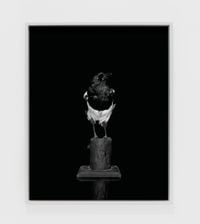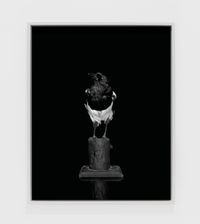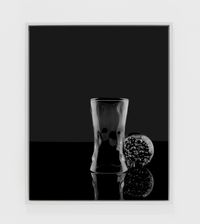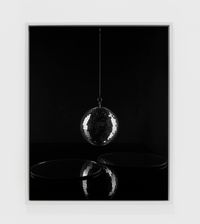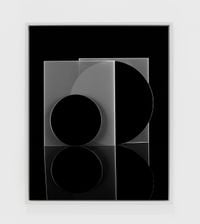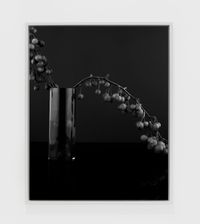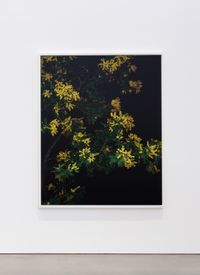Sarah Jones is a British photographer whose art practice embraces art history, psychoanalytic theory, Victorian history and childhood, drawing at times on the nuances of human behaviour amongst the children of the prosperous.
Read MoreHer works are contemplative and eerily still, with a big emphasis on light on surface, its absence and spatial depth. She uses a large format camera, and teaches at the Royal Academy in London.
Jones's photographic career took off in the mid-nineties after she graduated with a MA at Goldsmiths (1996). She previously completed a BA. Hons (1981) on Fine Art and Contemporary Dance. Aspects of the performative still surface in her image-making practice, though she is not a dancer herself. She likes to display elegant but politically loaded surfaces and form, but not movement. She enjoys working in isolation in her studio.
Sarah Jones' work is highly visual, with strong formal elements and a large scale, yet it is driven by an interest in narrative, especially when relevant to psychoanalysis, the history of film, girlhood, class, body language and myth.
Reoccurring subject-matter often occurs, such as suites of flowers (Mimosa (Actor) (1) (2021)); The Rose Gardens (display) (V), 2012)), horses (Horse (Dapple Grey) (1) (2017)), stuffed birds, trees (The Fig Tree (1999)), recently abandoned psychoanalytic couches, wrought iron fire-screens and bored, formally dressed, adolescent girls sitting at polished tables (The dining room table (Frances Place III) (1998); The dining room, Francis Place, 1997). She is keen on ongoing series of projects, exploring variations.
Jones basically constructs two types of photograph: one coloured and usually of teenagers posing in lavish country houses, or psychoanalysts' consulting rooms (Consulting room (Couch) (V) (1996)), or gardens; the other impenetrable inky black and charcoal grey with deep space, simple geometry, surface textures and shiny reflections (Mirror Ball (Narcissus) (I) (2021); Vitrine (IV) (for Eric Sander) (2017); Cabinet (V) (Two Spheres) (2014)).
In the latter Jones revels in different kinds of grey so that here is often a funereal ambience, a Victorian pallor of death. Sometimes certain motifs (like polished balls, shiny table tops, glittering glass ornaments, leafy branches, or roses) turn up in both.
Often the images bring out fetishistic aspects of the displayed objects, a sense that they are alive and worthy of worship.
Some works, such as Horse (black) (profile) (II/II) (2013), are in diptych form, giving the viewer the option of choosing an 'authentic' original and, like a Rorschach test, proffering a range of interpretations generated by the confusion. She was very impressed by the Surrealist poet Jean Cocteau's notion of 'the hall of mirrors' in his 1930 film, Blood of the Poet (Le Sang d'un Poète), where rows of mirrors (like in the halls of Versailles) are portals to other worlds, to be entered like reflecting pools of water (and perhaps infatuated, like Narcissus).
Hall of Mirrors was the name of Jones' 2021 Maureen Paley show in London.
Sarah Jones has been the subject of many solo and group exhibitions.
Recent Solo Exhibitions include Hall of Mirrors, Maureen Paley, London (2021); Sarah Jones: The Pleasure Gardens, Weinstein Hammons Gallery, Minneapolis (2019); Sarah Jones, Anton Kern Gallery, New York (2018); New Pictures 8, Minneapolis Institute of Arts, Minneapolis (2013); Sarah Jones: Photographs, National Media Museum, Bradford (2007).
Select group exhibitions include Tales of Manhattan, Anton Kern, New York (2021); The Enchanted Interior, Guildhall Art Gallery, London (2020); Un monde, un seul, pour demeure, Frac Nouvelle-Aquitaine, Bordeux (2019), The Language of Flowers (Revisited), Institut für Alles Mögliche, Berlin (2018), Animality, Marian Goodman Gallery, London (2016), 3rd International Tokyo Photo Biennale, Tokyo Metropolitan Museum of Photography (1999), Another Girl Another Planet, and Lawrence Rubin Greenberg Van Doren Fine Art, New York (1999).
John Hurrell | Ocula | 2021
